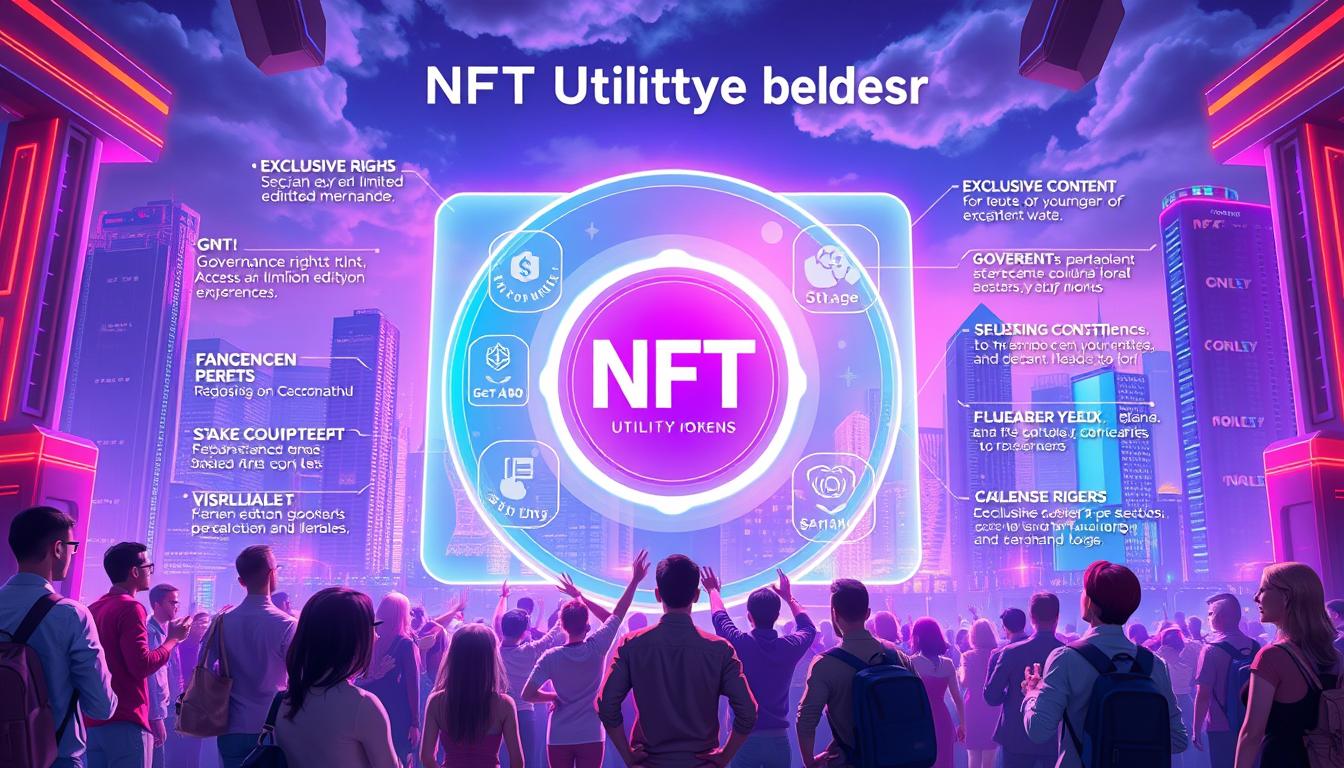Now Reading: Discover the Benefits of Being an NFT Utility Token Holder
- 01
Discover the Benefits of Being an NFT Utility Token Holder
Discover the Benefits of Being an NFT Utility Token Holder

The landscape of digital collectibles is evolving rapidly. This guide explores the multifaceted value proposition available in today’s dynamic economy.
These modern digital assets represent a significant shift from simple ownership. They offer tangible advantages, exclusive access, and practical uses that extend far beyond the digital realm.
As blockchain technology sees wider adoption across various sectors, grasping the full potential of these assets becomes essential. It helps in making informed decisions and maximising possible returns.
Owners can gain entry to unique experiences, governance rights, and membership privileges. These features create lasting value within innovative, decentralised ecosystems.
This examination covers real-world applications in fashion, entertainment, and sports. It demonstrates how these assets are transforming traditional industries and creating new opportunities.
Key Takeaways
- Modern digital assets offer real-world value beyond simple collectibility.
- Understanding this evolving space is crucial for informed participation.
- Ownership can unlock exclusive experiences and community privileges.
- Practical applications are emerging across diverse sectors like entertainment and fashion.
- Blockchain adoption is driving new opportunities for asset holders.
- These assets combine financial potential with active community involvement.
Overview of NFT Utility Tokens
Beyond their status as collectibles, certain digital assets on the blockchain offer a suite of practical rights and privileges. This functionality transforms them from simple items of ownership into active tools within a digital ecosystem.
Definition and Key Concepts
These specialised assets are defined by the advantages they grant. The economic models governing these advantages fall under the study of tokenomics. This framework dictates how value is created and distributed within decentralised systems.
The core advantages for participants can be grouped into three main areas. These include financial incentives, governance rights for project decisions, and exclusive access to services or content. This breadth of utility distinguishes them from traditional investments like stocks.
The underlying blockchain technology is crucial. It provides security, transparency, and verifiable proof of ownership. Key features like programmability allow for automated delivery of these perks.
The table below highlights the primary distinctions between these modern digital tokens and standard collectibles.
| Feature | Utility-Focused Digital Asset | Standard Digital Collectible |
|---|---|---|
| Primary Value | Ongoing rights & privileges | Scarcity & aesthetic appeal |
| Engagement Model | Sustained interaction within a platform | Often a one-time acquisition |
| Functionality | Programmable for specific applications | Typically static |
| Example Use Case | Access to loyalty and rewards programmes | Digital art piece |
Understanding these core concepts is the first step in evaluating the potential of any project in this innovative space.
Understanding NFT Utility Token Holder Benefits
The true potential of modern blockchain-based assets lies in their capacity to deliver ongoing advantages. These digital instruments provide more than just ownership status. They create meaningful participation in evolving ecosystems.
Financial Incentives and Governance Rights
Owners gain tangible economic value through various reward systems. Revenue-sharing programmes and staking opportunities create financial incentives. These mechanisms foster long-term loyalty among participants.
Governance rights represent a fundamental shift in how decisions are made. Asset holders can influence a project‘s direction through voting mechanisms. This democratic approach contrasts with traditional corporate structures.
| Advantage Category | Specific Benefits | Impact on Engagement |
|---|---|---|
| Financial Rewards | Revenue sharing, staking yields | Increased long-term commitment |
| Governance Participation | Voting on features, treasury allocation | Active community involvement |
| Exclusive Privileges | Early product access, premium content | Enhanced user experience |
Exclusive Access and Unique Experiences
Special access to private communities creates a sense of belonging. Invitation-only events and early product releases offer distinct privileges. These opportunities are unavailable to the general public.
Unique experiences range from virtual meet-and-greets to beta testing participation. Personalised interactions within exclusive digital spaces enhance engagement. This combination creates a compelling value proposition for interested parties.
The Evolution of Tokenomics and Digital Assets
The history of programmable assets is marked by pivotal moments that expanded their functionality far beyond initial expectations. This progression illustrates how digital ownership models have matured into sophisticated ecosystems.
Historical Milestones in Tokenomics
Early digital currencies offered value primarily through speculation. Owners hoped for price appreciation rather than receiving ongoing benefits.
The landscape changed dramatically with Ethereum’s launch. This blockchain platform introduced a revolutionary concept: smart contracts.
The Impact of Smart Contracts
Smart contracts allowed developers to embed specific features directly into an asset’s code. This technology enabled automated rewards and access rights.
This integration meant perks like governance voting or staking yields could be delivered transparently. It reduced reliance on centralised authorities.
| Era | Primary Focus | Key Innovation |
|---|---|---|
| Early Cryptocurrencies | Speculative value | Digital scarcity |
| Post-Ethereum (2015) | Programmable functionality | Smart contract technology |
| Modern Systems | Comprehensive utility | Diverse ecosystem integration |
Subsequent developments, like the rise of dApps, further broadened the scope. These platforms created environments where assets served as keys for access and participation. Understanding this trajectory helps appreciate the sophisticated value proposition of contemporary digital assets.
Blockchain Technology and Its Impact on Utility
Blockchain systems provide the essential infrastructure that transforms simple digital ownership into interactive participation. This technological foundation creates immutable records that verify ownership and track distribution without centralised control.

The decentralised nature of these systems ensures no single entity controls digital asset functionality. Smart contracts automatically execute predetermined functions, creating trustless environments for participants.
Transparency and Decentralised Governance
Transparency represents a critical advantage of this technological approach. All transactions and ownership transfers appear on publicly verifiable ledgers. This visibility reduces fraud and increases confidence among digital asset owners.
Tokenisation converts real-world assets into digital tokens on distributed ledgers. This process establishes direct relationships between creators and participants while eliminating intermediaries. The efficiency gains include reduced costs and faster delivery of privileges.
Decentralised governance structures allow digital asset owners to participate in decision-making. Secure voting mechanisms cannot be manipulated, ensuring fair participation. Understanding blockchain’s impact on functionality helps evaluate any project’s reliability.
Security features inherent in this technology protect against counterfeiting and unauthorised access. Cryptographic protocols ensure only legitimate owners can access their entitled privileges. This fundamental transformation empowers participants with verifiable ownership within digital ecosystems.
Maximising Your Investment in NFT Utility Tokens
Strategic participation in digital ecosystems requires careful planning beyond initial acquisition. A thoughtful approach considers both immediate advantages and future growth potential within each project’s framework.
Strategies for Long-Term Value
Successful investors prioritise projects with strong fundamentals. Experienced teams, clear roadmaps, and active communities signal sustainable development. These elements significantly increase the likelihood of sustained value appreciation.
Diversification across multiple digital assets reduces risk while providing exposure to various industries. This strategy creates balanced opportunities within the broader ecosystem. Each project offers distinct advantages worth exploring.
Active participation enhances overall returns. Engaging in governance decisions influences project direction meaningfully. Staking available digital assets generates passive rewards while building network effects.
Understanding specific functionalities enables maximum benefit realisation. Regularly using platform features and redeeming exclusive access optimises your experience. This active engagement fosters deeper loyalty and compounding advantages.
Monitoring development milestones and partnership announcements provides crucial insights. This information helps identify optimal timing for position adjustments. Alignment between personal interests and project offerings remains essential for success.
Real-World Applications and Use Cases
Practical implementations are demonstrating the transformative power of digital assets across major industries. These applications solve real problems and create new value for both organisations and participants.

Utility in Event Management
The event industry faces significant challenges like ticket fraud. A recent CNBC report revealed a staggering 12% of all ticket purchases are fraudulent.
Tokenisation offers powerful solutions. It converts tickets into secure digital assets on a blockchain. This process introduces transparency and eliminates counterfeit tickets.
For example, during a major concert tour, some tickets were resold for up to $22,000. This technology helps organisers regain control. It also establishes a direct relationship with attendees.
Owners gain more than just entry. They receive VIP access, exclusive merchandise, and unique experiences. These perks enhance attendee engagement and build lasting loyalty.
Digital Assets in Fashion and Entertainment
In fashion, these digital instruments serve as proof of ownership and authentication tools. They combat counterfeiting for high-value physical items.
Brands also use them to grant special access to virtual fashion shows or limited-edition releases. This creates scarcity and fosters a dedicated community of collectors.
The entertainment sector leverages them for exclusive content and backstage experiences. This transforms passive fans into active community participants.
These applications show how value flows in both directions. Participants receive tangible perks, while companies gain engaged audiences and valuable data.
| Industry | Primary Challenge Addressed | Key Advantages for Participants |
|---|---|---|
| Event Management | Ticket fraud and scalping | Secure entry, exclusive perks, collectible memorabilia |
| Fashion | Counterfeiting and brand authenticity | Proof of ownership, access to limited items, community status |
| Entertainment | Passive consumer engagement | Royalty participation, unique interactions, premium content |
Leading Projects and Innovative Examples
Several pioneering initiatives have successfully bridged the gap between digital ownership and real-world privileges. These programmes demonstrate how modern digital assets create meaningful engagement through exclusive offerings.
The Coachella Keys Collection represents a premium example in the entertainment sector. Ten unique digital assets offered lifetime festival passes with luxury amenities.
Case Study: Unique Network Partnerships
Unique Network’s collaborations showcase practical business-to-business applications. Their work with Dundas during Paris Fashion Week provided Proof of Attendance tokens to 340 guests.
This partnership demonstrates how digital assets can enhance real-world experiences. The integration with Lemonade Social created advanced ticketing systems for web3 events.
Sorare’s success with nearly 4 million users highlights mass-market adoption. Their football card platform engages sports enthusiasts through collectible player assets.
| Project | Industry Focus | Key Features | User Engagement |
|---|---|---|---|
| Coachella Keys | Entertainment & Events | Lifetime access, VIP experiences | Exclusive community |
| Tiffany NFTiffs | Luxury Goods | Digital-to-physical conversion | High-value collectors |
| Unique Network | Fashion & Technology | Attendance verification, ticketing | Event participants |
| Sorare | Sports & Gaming | Player cards, fantasy sports | 4 million users |
| Flyfish Club | Hospitality | Membership-based dining | Private community |
Flyfish Club introduced the world’s first membership-gated private dining establishment. Their tiered access model ranges from standard to exclusive omakase experiences.
These case studies illustrate diverse applications across multiple sectors. They prove the versatility of this technology and business model for creating value.
Utility and Customisation for Exclusive Experiences
Personalisation transforms digital assets from standardised items into unique, memorable possessions. This approach creates deeper emotional connections between participants and projects. The focus shifts from generic ownership to individually tailored experiences.

Customised Digital Tickets
Event access becomes personalised through advanced customisation features. Tickets can incorporate attendee names, photographs, and specific preferences. This makes each digital asset unique to its owner.
The possibilities extend to personalised merchandise and individualised VIP packages. Content delivery can be tailored based on participant interests. These features significantly enhance the perceived value of ownership.
Gamification for Enhanced Engagement
Gamification strategies create interactive experiences that boost participation. Organisers design treasure hunts and location-based challenges. Participants collect digital assets by completing specific tasks at various venues.
Rewards might include enhanced digital items, physical merchandise, or premium content access. This approach fosters excitement and sustained engagement throughout events. The system provides clear incentives for active involvement.
| Feature | Customised Digital Asset | Standard Digital Asset |
|---|---|---|
| Personalisation Level | High – name, photo, preferences | Low – generic design |
| Participant Engagement | Active through gamification | Mostly passive ownership |
| Emotional Connection | Strong through custom features | Limited to aesthetic appeal |
| Example Application | Personalised event tickets with rewards | Standard digital collectible |
The combination of customisation and gamification creates powerful opportunities for meaningful interaction. These digital instruments serve as both access keys and evolving tools. They adapt based on participant actions and engagement levels.
Securing and Managing Your Digital Assets
Protecting your digital investments requires a comprehensive security strategy that extends beyond basic ownership. Proper measures safeguard both the assets themselves and the privileges they provide.
Selecting reputable wallet solutions forms the foundation of secure management. Hardware wallets offer maximum protection for significant holdings. Software options provide convenience for frequent access.
Best Practices for Digital Security
Private key management represents the most critical security consideration. These cryptographic keys grant complete control over your digital possessions. They must never be shared or stored without encryption.
Enable multi-factor authentication on all connected platforms and services. This adds crucial protection layers against unauthorised access. Even compromised passwords cannot bypass this security feature.
Regular security audits help identify potential vulnerabilities before problems occur. Review connected wallets and authorised applications periodically. Monitor smart contract interactions for suspicious activities.
Phishing awareness remains essential against social engineering attacks. Verify website URLs before entering any credentials. Confirm authenticity of communications claiming to be from support teams.
Establish reliable backup and recovery procedures for your assets. Store seed phrases securely in multiple physical locations. This ensures recovery options if primary access methods fail.
Data Insights and Analytics for NFT Investors
Investment strategies in the digital asset space are being revolutionised by the wealth of information available through blockchain analytics. The transparent nature of distributed ledger technology creates comprehensive records of participant behaviour and interaction patterns.

This wealth of information provides unprecedented visibility into how people engage with various features and offerings. Both investors and project developers can leverage these insights to make more informed choices.
Leveraging Blockchain Data for Engagement
When event tickets and merchandise become digital assets on a blockchain, organisers gain valuable intelligence about attendee preferences. They can track booth visits, session attendance, and interaction patterns with remarkable precision.
This data helps understand what features participants value most. It reveals networking connections and shared experiences within exclusive communities.
Sponsorship return on investment becomes measurable through concrete interaction metrics. Brands can see how their promotional offers and content perform with engaged audiences.
| Data Category | Specific Metrics | Practical Applications |
|---|---|---|
| Engagement Tracking | Session attendance, feature usage | Optimise event programming |
| Preference Analysis | Content interaction, reward redemption | Personalise future offerings |
| Social Dynamics | Network connections, shared activities | Enhance community building |
| Loyalty Patterns | Repeat attendance, consistent participation | Develop retention strategies |
Post-event surveys linked to digital assets achieve higher response rates from invested participants. The immediate feedback helps projects refine their approach and identify expansion opportunities.
For example, analysing which members consistently redeem privileges and participate in governance helps identify the most valuable community contributors. This intelligence supports targeted outreach and programme improvements.
Future Trends in NFT Utility and Blockchain Integration
The convergence of blockchain with emerging technologies opens unprecedented possibilities for digital asset functionality. This integration promises to transform how these instruments create value across multiple sectors.
Emerging Innovations and Applications
Virtual and augmented reality represent significant frontiers for development. These technologies enable immersive experiences like virtual concert venues and interactive art galleries.
Customisation options will become increasingly sophisticated. Projects can create personalised experiences through adaptive content and unique digital environments.
Environmental sustainability is gaining importance. Future developments focus on eco-friendly solutions and energy-efficient blockchain networks.
| Current Features | Future Innovations | Industry Impact |
|---|---|---|
| Basic digital access | Immersive VR experiences | Entertainment and events |
| Standard governance | Advanced voting systems | Community decision-making |
| Single-platform use | Cross-platform interoperability | Multiple service integration |
| Static benefits | AI-adaptive features | Personalised value creation |
Artificial intelligence integration will enable dynamic assets that adapt to user behaviour. This creates more responsive value propositions tailored to individual preferences.
Regulatory clarity expected in coming years will legitimise markets. This development could open access to institutional investors and mainstream adoption.
Conclusion
As we conclude our exploration, it becomes clear that modern digital ownership extends far beyond mere possession. These innovative instruments represent a fundamental shift in how value is created and distributed within digital ecosystems.
The practical benefits for participants span financial rewards, governance participation, and exclusive access. Real-world applications across various industries demonstrate their versatility in solving specific challenges while enhancing user experiences.
Looking ahead, the integration of emerging technologies promises even greater potential for these digital assets. For those considering participation, understanding both the opportunities and necessary precautions ensures informed decision-making in this dynamic space.
FAQ
What exactly is an NFT utility token?
An NFT utility token is a digital asset on a blockchain that provides specific privileges beyond simple ownership. These privileges can include access to services, voting rights on project decisions, or entry to exclusive events. They are designed to offer real-world value and foster deeper engagement within a digital ecosystem.
How do these tokens differ from standard cryptocurrencies?
Unlike standard cryptocurrencies like Bitcoin, which primarily function as a medium of exchange, utility tokens grant access to a project’s features or services. Their value is often linked to the adoption and success of the platform they support, rather than just market speculation.
What kind of exclusive access can a holder expect?
Holders may receive perks such as early entry to content drops, invitations to private online communities, or unique digital and physical experiences. For instance, a token might act as a backstage pass for a virtual concert or provide discounts on future platform purchases.
Can you explain how governance rights work for holders?
Governance rights allow individuals to participate in shaping a project’s future. This often involves voting on proposals, such as feature updates or fund allocation. This democratic approach gives the community a direct voice in key developments, enhancing transparency and loyalty.
Are there any financial incentives associated with holding these assets?
Yes, potential financial incentives can include earning rewards through staking mechanisms, receiving a share of platform revenue, or benefiting from the appreciation of the asset’s value as the project grows and gains wider adoption.
What industries are adopting this technology most actively?
The gaming, entertainment, and fashion sectors are leading the way. Projects are creating unique digital wearables, customised event tickets, and interactive experiences that leverage blockchain’s capabilities for authenticity and user engagement.
How can I ensure the security of my digital assets?
It is crucial to use a reputable hardware wallet for storage, enable two-factor authentication on all related accounts, and never share private keys. Regularly updating software and staying informed about security best practices are also essential steps.
What future trends are emerging in this space?
We are seeing a move towards greater interoperability between different platforms and the integration of artificial intelligence to create more personalised user experiences. The use of blockchain for verifiable data insights is also a significant growing trend.














